It is often said that a human spends a third of his life sleeping. I believe a woodworker spends a third of his working life sanding! At least that’s how the past 20 years have been for me. And one of the greatest mistakes I’ve seen people make is misinterpreting wet sanding. So, can you sand wet wood?
You cannot sand wet wood because the water content in wood makes it sanding-resistant meaning the sandpaper essentially sticks to the surface. Wet wood must be dried before it is sanded, or the results will be uneven, and the wood surface might even crack! Sanding wet wood is not the same as wet sanding, which is done on dry lumber.
In this article, you will discover the difference between wet sanding and sanding wet wood. You will also learn why wet sanding is beneficial and why sanding wet wood leads to ruined furniture and ill-spent time. This post draws from 20 years of woodworking experience and is meant to be a one-stop resource on moisture and sanding.
Let’s get started with a look at the main differences between wet and dry sanding.
| Wet sanding | Dry sanding | |
|---|---|---|
| Definition | Using special soaked sandpaper to sand a surface | Using average sandpaper while it is dry |
| Best Application | To make a delicate surface smoother | To rough up a surface so it can be painted over or coated better |
| Not ideal for | Adhesion-related sanding or priming | As a finishing method for expensive wood |
| Best point | It mandates care | It is quick and easy |
| Worst point | It takes a long time to pull off | It can lead to errors of haste and oversight |
Be sure to go here to check out my article on Should you wet wood before sanding?
Does Wood Need To Be Dry to Sand?
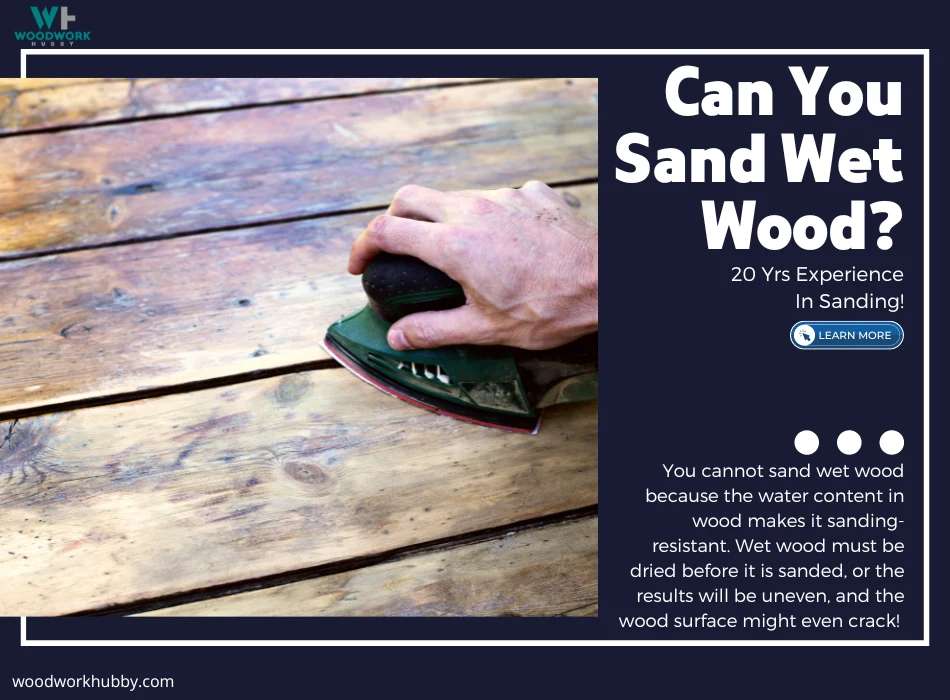
Wood needs to be dry before you sand it because sanding requires friction. For optimal friction, there has to be as little moisture and water on the wood as is practically possible. The grit of your sandpaper or type of wood doesn’t make an exception to this rule.
If you sand wet wood, you just ruin your sandpaper, get scratch streaks on the wood, and have to wait until the wood is completely dry to reattempt sanding.
The consequences of attempting to sand wood aren’t very severe. But it is a waste of time, energy, and sandpaper.
Even a thorough academic study of the properties of wood species and grit size found nothing to indicate that either of those metrics would make wet wood more “sandable.”
Wood takes around 48 hours to dry indoors and 24 hours outdoors. This is the period you can expect to wait before you can start sanding wood. If you use a power sanding tool, you’ll be able to sand earlier than if you hand sand. But in neither sanding method will you be able to sand wood within 24 hours of it being drenched.
Is It Better to Sand Wood Wet or Dry?
It is better to sand dry wood than wet wood, because wet wood is nearly impossible to sand. However, washing a dusty wood surface is advisable before sanding, provided that you can wait 24 to 48 hours for the surface to dry.
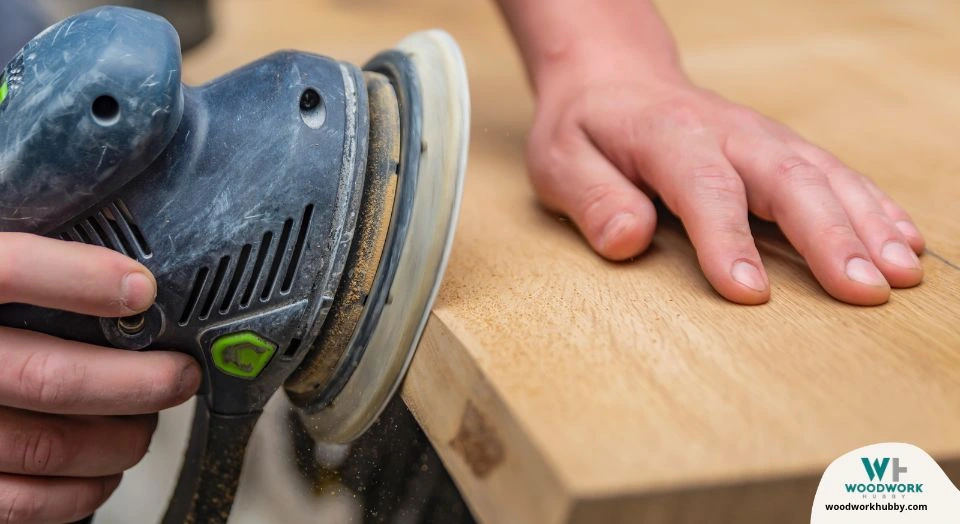
Sanding produces sawdust, and if a wood surface is already dusty, one can have breathing problems. I can’t remember a time when I sanded dusty wood without having a sneezing fit. You might be tempted to wet the wood to avoid airborne sanding dust. But that will only make sanding harder.
To the extent that you will sand wet wood, there won’t be any airborne sanding dust. It is an effective strategy to minimize sanding dust. However, you will get 1% sanding done. A much better way to reduce the amount of dust you inhale when you sand dry wood is to wear a respirator.
Stealth Respirator Mask is reasonably priced, hovering around $20. It protects you from dust, sand, and unpleasant odors associated with staining and painting practices. There are no protective goggles with this mask, so you’ll have to purchase them separately.
Stealth Respirator Mask
But what’s great about this respirator is that it fits well and has multiple filters that can be swapped. With over 162 reviews and ratings, this product has a global average of 4.4 stars on a 5-star scale.
What Is Dry Sanding?
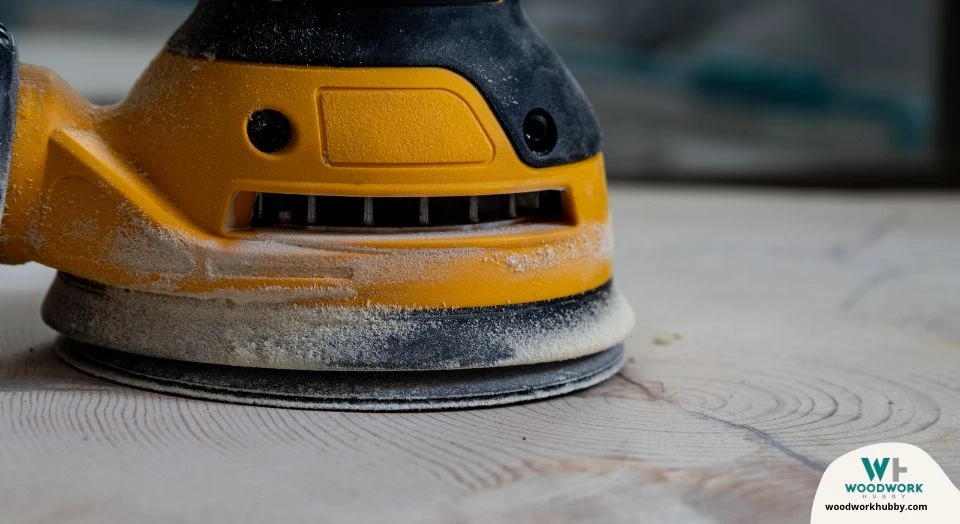
Dry sanding is the act of using dry sandpaper on dry wood. This is the quickest way to sand a wood surface as it maximizes friction. The drawback of this method is that it makes the bulk of the sanding dust airborne almost immediately.
This method is best assisted with a respirator and goggles and is often used for medium-priced and low-priced lumber. More often than dust, wet sanding is chosen to preserve wood surfaces from unnecessary scratches.
Dry sanding can be done in haste, and the drawbacks of rushed sanding can be as follows:
- Missed areas – It is very easy to overlook small areas in a large sanding project. This is hard to detect at the sanding stage. But when you paint over the sanded surface, the missed areas don’t hold paint as well, which leads to chipping.
- Cross texture – Sometimes, the sanding action is so rough and free of cohesion that the creases it leaves on the wood are in a zig-zag relative to each other. If the wood item is meant to have any decor value, such sanding ruins it.
- Poor depth level – You can sand at different depths. You just need to make sure it is on the same level. When you dry sand with your hands, you might not maintain even pressure throughout the sanding process. It is advisable to sand with a thick block or use sanding power tools when using dry sanding.
- Sandpaper clogging – Finally, a major inconvenience with dry sanding is that sanded particles can get lodged in the sandpaper. This not only clogs the sandpaper but also creates an uneven sanding surface that results in deep scratches on the wood.
The following video shows how you can pull off wet sanding with minimal marks.
The video shows how to wet sand
Wet sanding slows down the sanding process but introduces care to the overall equation. That said, most people erroneously believe that wet sanding means sanding wet wood.
What Is Wet Sanding?
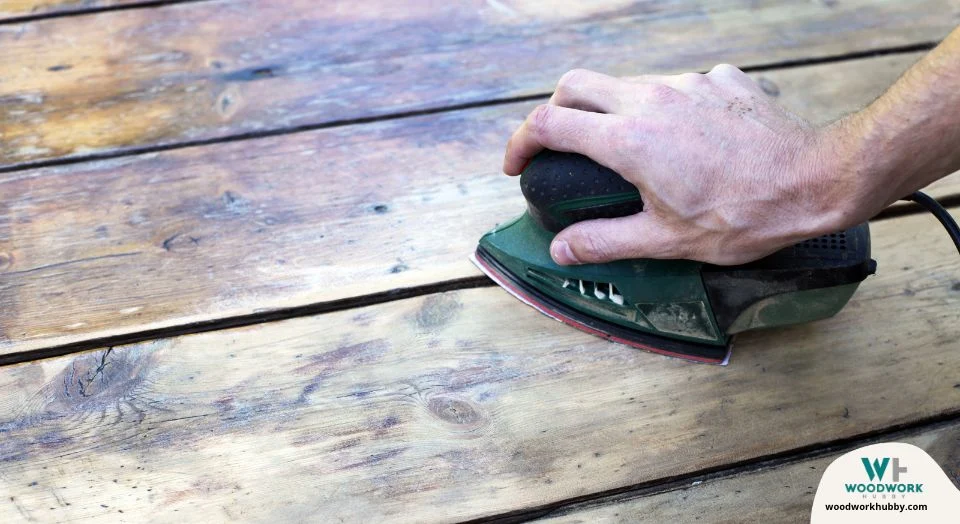
Wet sanding entails using sandpaper that is built to sand while it is wet. This reduces airborne sanding dust and makes the sanding process more gentle. It is often used to protect expensive wood when sanding is required but can be risky.
The misconceptions related to wet sanding fall into two categories.
- The first is the belief that wet sanding entails sanding wet wood with regular sandpaper. This is not true because wet wood cannot be sanded. Moreover, it is not good practice to drench wood in general.
- The second misconception is closer to the truth but is still false. Some people believe that wet sanding is done by soaking regular sandpaper. The average dry sandpaper falls apart when wet and loses its effectiveness quite rapidly. When you choose to wet sand wood, you need special sandpaper made for wet sanding.
Wet sanding without special sandpaper will ruin your sander at best and the wood at worst. Given that wet sanding is done on expensive wood, the use of regular sandpaper to wet sand is quite risky.
But if you want to wet sand a very small surface and dry sand a bulk of your projects, you might hesitate to buy wet sandpaper. Fortunately, most sandpaper manufacturers have introduced “Dry and Wet” options that work perfectly well dry as well as soaked.
WaterLuu Wet & Dry Sandpapers Kit is an excellent purchase as it contains 42 sandpapers ranging from 120 to 3000 grit. And each of the sandpapers can be used dry or wet. It comes with a sanding block, so you can hand-sand with ease.
WaterLuu Wet & Dry Sandpapers
At around $15, this is a must-have for any semi-professional workshop. With over 2,200 reviews and ratings, WaterLuu Wet & Dry Sandpapers have a global average rating of 4.6 out of 5 stars. It has a 4.7 rating for being easy to hold and a 4.5 rating for its value for money.
Benefits of Wet Sanding
As you know by now, dry sanding has a few drawbacks, especially when it is employed on expensive wood. Wet sanding introduces care to the equation, which has its own benefits.
Here are all the advantages of wet sanding:
- Smoother finish – One of the best things about wet sanding is that it produces a predictably smooth finish because it doesn’t sand at an intrusive depth.
- Fewer scratches – Dry sanding can leave harsh scratch marks, while wet sanding rarely has such a harsh footprint. Still, the risk of scratching is present regardless of the sanding method, and nothing replaces the role of care when sanding.
- Even sanding – When sanding with dry sandpaper, loose particles can get lodged in between the peaks of the paper and form deeper peaks that can scratch the wood at random depths. Moreover, dry sanding is often hasty, which can make keeping even pressure throughout the process quite difficult.
- Fewer missed areas – Again, the slower process of wet sanding mandates care. And with careful sanding, one misses fewer areas. Ironically, wet sanding is done as a finishing task as opposed to priming. It is in priming when missed areas become the most problematic. This benefit doesn’t go a long way in most cases.
What Happens if You Dry Sand Wet Wood?
By now, it is clear that using regular sandpaper on wet wood isn’t wet sanding. It is just drying and sanding wet wood, which is not advisable.
Dry sanding wet wood can lead to a range of undesirable results.
- Uneven sanding – You’ll have to put in more effort and sand rigorously. Still, the outcome will look uneven, with major peaks and valleys across the surface.
- Surface cracking – Wet wood starts cracking when it is put under the pressure of an active sanding process.
- Smudges on the surface – Finally, the result of sanding wet wood with dry (or wet) sandpaper is that there is more smudging than sanding.
What Moisture Content Is Ideal?
8% is the ideal moisture content for sanding wood, though 7% to 9% is considered perfectly workable. If the moisture gets any lower than 6%, the wood becomes too brittle for sanding. You don’t need to wet wood to get it to 7% moisture because wood naturally has 8% moisture.
It is better to err on the side of dry wood because the likelihood of having brittle wood is too small. On the other hand, having wood sit around in humidity can be enough to make it too moist for sanding.
I’ve got the answer about whether you should wet wood before sanding. Be sure to check it out!
Can You Wet Sand Painted Wood?
You can wet sand-painted wood if the paint is waterproof. If the paint reacts adversely to water or moisture, then wet sanding is a bad idea. Often, wet sanding is used as a finishing technique, which makes it better suited for painted surfaces, just not water-vulnerable ones.
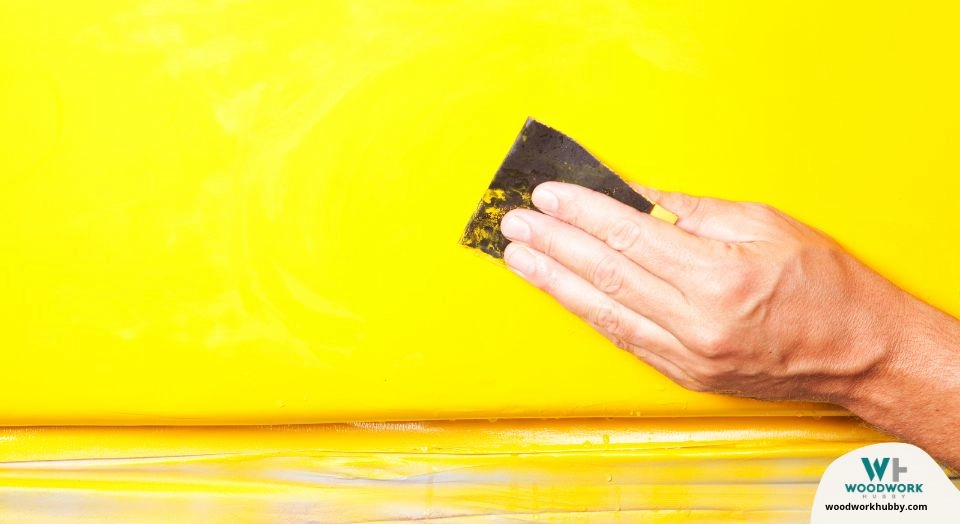
I found the solution to whether you should sand wood after staining. Click the link to find out more!
Can You Wet Sand Varnish?
You can almost always wet sand the varnish. It is advisable to avoid dry sanding varnish because the dry sanding action can actually remove the varnish altogether. In contrast, wet sanding can make varnish smoother.
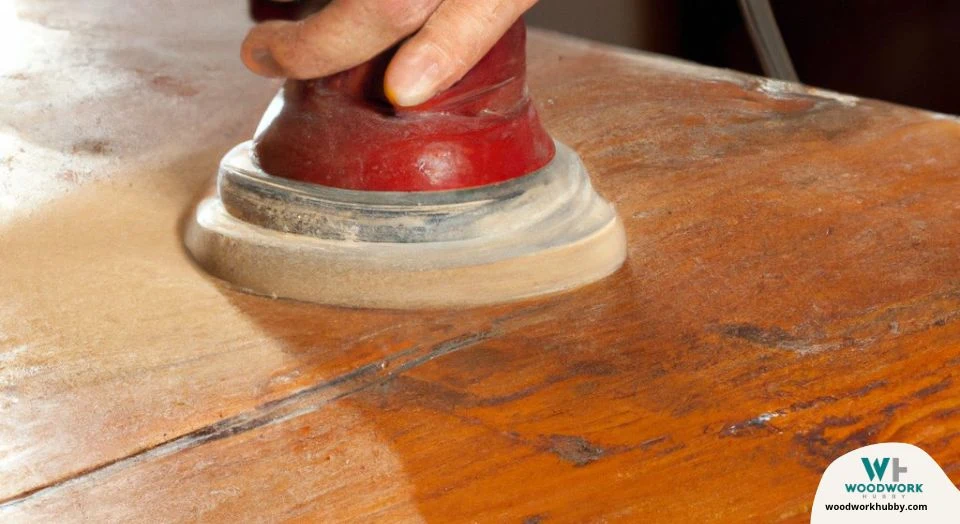
Wet sanding varnish isn’t recommended as a varnish removal tactic. If you want to sand a surface to remove a coat, dry sanding should be your method of choice. The following video shows what you can expect from wet sanding wood.
The video shows wet sanding wood
Wet sanding lacquer requires a degree of care. The following video shows that you can take a few liberties with wet sandpaper and still have the lacquer coat intact by the end of your sanding process.
Video shows wet sanding lacquer
Wet sanding surfaces like a car door or a polished decor item require extra care. There is always the possibility of scruff marks.
Final Thoughts – Can You Sand Wet Wood
You can sand wet wood if you want to ruin the surface. For the most part, you should let wet wood sit for 24 hours so it is dry enough to sand. Wet sanding is a different thing and is done on dry wood. The sandpaper, and not the wood, is wet.






